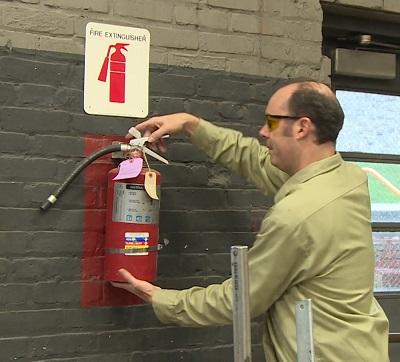Introduction: How Do Fire Extinguishers Work?
Today’s fire extinguishers use either water or foam to put out fires. Fire extinguishers are designed to be easily operated by people of all sizes. A fire extinguisher is a safety device that can be used to extinguish the flames of a small fire. A fire extinguisher consists of a hand-held cylinder or canister containing an agent which can be discharged to suppress the combustion by expelling it over the target.
A fire extinguisher is an active fire protection tool utilized to extinguish or manage tiny fires, often in emergency scenarios. It is not meant for use on an out-of-control fire, such as one which has gotten to the ceiling, endangers the people around (i.e., no getaway path, smoke, explosion threat, etc.), or otherwise needs fire equipment or firefighting personnel. Generally, a fire extinguisher consists of a hand-held cylindrical pressure vessel containing an agent that can be released to snuff out a fire.
There are two significant kinds of fire extinguishers: stored-pressure and cartridge-operated. In stored pressure units, the expellant is kept in the same chamber as the firefighting agent itself. Different propellants (fuels) are utilized depending on the firefighting agent used. With dry chemical extinguishers, nitrogen is often employed; water and foam extinguishers generally utilize air. Stored pressure fire extinguishers are the most typical. Cartridge-operated extinguishers have the expellant gas in a separate cartridge that is penetrated before release, exposing the propellant to the extinguishing agent. This type is ordinarily used for factory or industrial settings, where they can be used repeatedly and frequently. They have the benefit of straightforward and timely recharge, permitting a driver to release the extinguisher, reenergize it, and return to the fire in a reasonable amount of time. Unlike stored pressure types, these extinguishers use compressed CO2 instead of nitrogen, although nitrogen cartridges are utilized on low-temperature versions. Cartridge-operated extinguishers are offered in dry chemical and also dry chemical and dry powder types in the U.S., and in water, wetting agent, foam, dry chemical (classes ABC as well as BC), and also dry powder (course D).
How To Use a Fire Extinguisher
Fire extinguishers are typically located near exit points or potential hazards. The general rule with most fire extinguishers is to aim at the base of the flames, not the top. This will prevent the flame from being blown out and will instead smother it out.
Use the following steps when responding to an emerging fire:
- Activate the fire alarm
- Call your local fire department, depending on the circumstance
- Locate a safe evacuation route prior to moving towards the fire.
- Avoid an evacuation route near fire, heat, or smoke.
- Choose the correct type of fire extinguisher (classes ABC as well as BC).
- Put yourself within the “effective range” that is marked on the extinguisher’s label. For most dry chemical ABC fire extinguishers, this distance will be about 6 to 8 feet.
- Hold the extinguisher upright.
- Discharge the extinguisher within its effective range using the P.A.S.S. technique (pull, aim, squeeze, sweep).
- Move away from an extinguished fire just in case it flames up again.
- Evacuate as soon as possible if the extinguisher is empty and the fire is not out.
- Evacuate immediately if the fire progresses beyond the incipient stage.
Using the P.A.S.S. technique (Even under the stress of fighting a fire, you can make sure you use the extinguisher correctly by thinking of the word “PASS” ):
It spells out the four steps you should take.
— Pull the extinguisher’s pin.
— Aim the nozzle at the base of the fire.
— Squeeze the trigger.
— Sweep from side to side with a slow, steady motion.
Remember that retardants cool and smother a fire by working on its fuel.
- So keep the nozzle of the extinguisher pointed at the base of the fire, not the flames.
If you are dealing with flammable liquids, be careful not to spread the fire by “splashing” the spill.
As the fire gets smaller, step forward to stay within the extinguisher’s “effective range.”
- But don’t get too close.
- Be careful where you walk!
If fighting the fire is creating a lot of smoke, crouch down near the ground.
- There will be more fresh air there, and it will be easier for you to see.
- Most portable dry chemical extinguishers provide about 10 to 15 seconds’ worth of continuous spraying.
The Different Types of Fire Extinguishers
There are different types of fire extinguishers, and each type of fire extinguisher is designed to work on a specific kind of fire. Some common types of fire extinguishers include water, dry chemical, and carbon dioxide.
“Class A” fires involve everyday solid combustibles like paper, cardboard, and wood.
Extinguishers that discharge water, foam, and some dry chemical agents can be used on this class of fires.
“Class B” fires involve flammable gases, liquids, and some plastics.
Extinguishers that discharge dry chemicals, foam, and carbon dioxide should be used on these.
“Class C” fires involve electricity and can occur in any electrical equipment.
Extinguishers that apply “nonconductive” substances, such as carbon dioxide and dry chemicals, must be used on Class C fires.
“Class D” fires involve combustible metals and are not very common.
They can be dangerous to extinguish, so don’t try to put out a Class D fire unless you have received training on dealing with them specifically.
Fire extinguishers are always marked with labels that indicate the classes of fires they should be used on. Sometimes they also display “pictographs” that illustrate the classes.
—
To view a free demonstration of the fire extinguisher training class, please view our fire extinguisher training demo.










